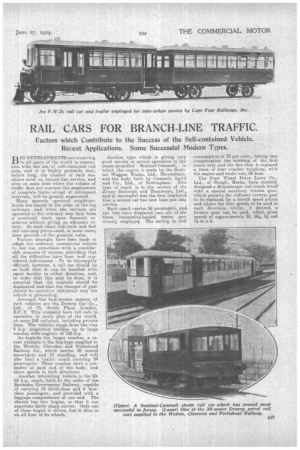RAIL CARS FOR BRANCH-LINE TRAFFIC.
Page 21

If you've noticed an error in this article please click here to report it so we can fix it.
Factors which Contribute to the Success of the Self-contained Vehicle. Recent Applications. Some Successful Modern Types.
BIG DEVELOPMENTS are occurring in all parts of the -world in connection with the use of self-contained rail cars, and it is highly probable that, before long, the number of such machines used on brarieh-line service, and even on main lines where the volume of traffic does not warrant the employment of complete trains except at infrequent intervals, will he greatly augmented.
Many sparsely operated neighbourhoods are thorns in the sides of the big railways, And when the services are operated in the ordinary way they form a continual drain upon financial resources without giving an adequate return. In such cases well-built and fast rail cars may prove—and, in some eases, have proved—of the greatest value.
Various attempts have been made to adapt the ordinary commercial vehicle to rail use, sometimes. with a considerable measure of success, providing that all the difficulties have been well considered beforehand. To be thorough)y efficient, however, a rail car should be so built that it can be handled with equal facility in either direction, and, in order that this may be done, it is essential that the controls should be duplicated and that the changes of gear should be operative whichever way the vehicle is proceeding'.
Amongst the test-known makers of such vehicles are the Drewry Oar Co., Ltd., of 13, South' Place, London, E.-C.2. This compiny have rail cars in operation in every part of the world, on some 250 railways, including private lines. The vehicles range from the tiny '4 .h.p, inspection trolleys up to large coaches with engines of 150 h.p. As regards the larger coaches, a recent example is the finettype supplied to the Weston, Clevedon and Pomtishead Railway Co., which carries 30 seated passengers and 12 standing, And will also haul a trailer coach carrying 24 passengers. These coaches have a controller at each end of the body, 'an4 three speeds in both directions.
Another interesting vehicle is the 60.65 h.p. coach, built to the order of the Barbados Government Railway, capable
of carrying 35 third-class and 9 first class passengers, and provided with a luggage compartment at one end. The chassis has two bogies, so that it can negotiate fairly sharp curves. Only one of these bogies is driven, but it does so on all four of its wheels. Another type which is giving very good service in act i
actual operation s the steam-propelled Sentinel-Cammell, in which the engine is made by the Sentinel Waggon Works, Ltd., Shrewsbury, and the body built by Cam-mall, Laird , and Co., Ltd., of Nottingham. This type of coach is in the service of the Jersey Railways and Train-ways, Ltd., and so successful was the first employed that a second car has now been put into service.
Each coach carries 56 passengers' and the two have displaced two out of the three locomotive-hauled -trains previously employed. The saving in coal
consumption is 72 per cent., taking into consideration the working ol the first coach only and the fact that it replaced a train of four coaches weighing, with the engine and brake van, 56 tons.
The Four Wheel Drive Lorry Co., Ltd., of Slough, Bucks, have recently designed a 36-passenger rail coach fitted` with a special auxiliary reverse gear, which permits the ordinary reverse gear to be replaced by a fourth speed pinion and allows the four speeds to be used in each direction, Whilst, if desired, a booster -gear can.. be -used, which gives speeds of approximately 33, 16i, BIand 5,4 m.p.h.
































